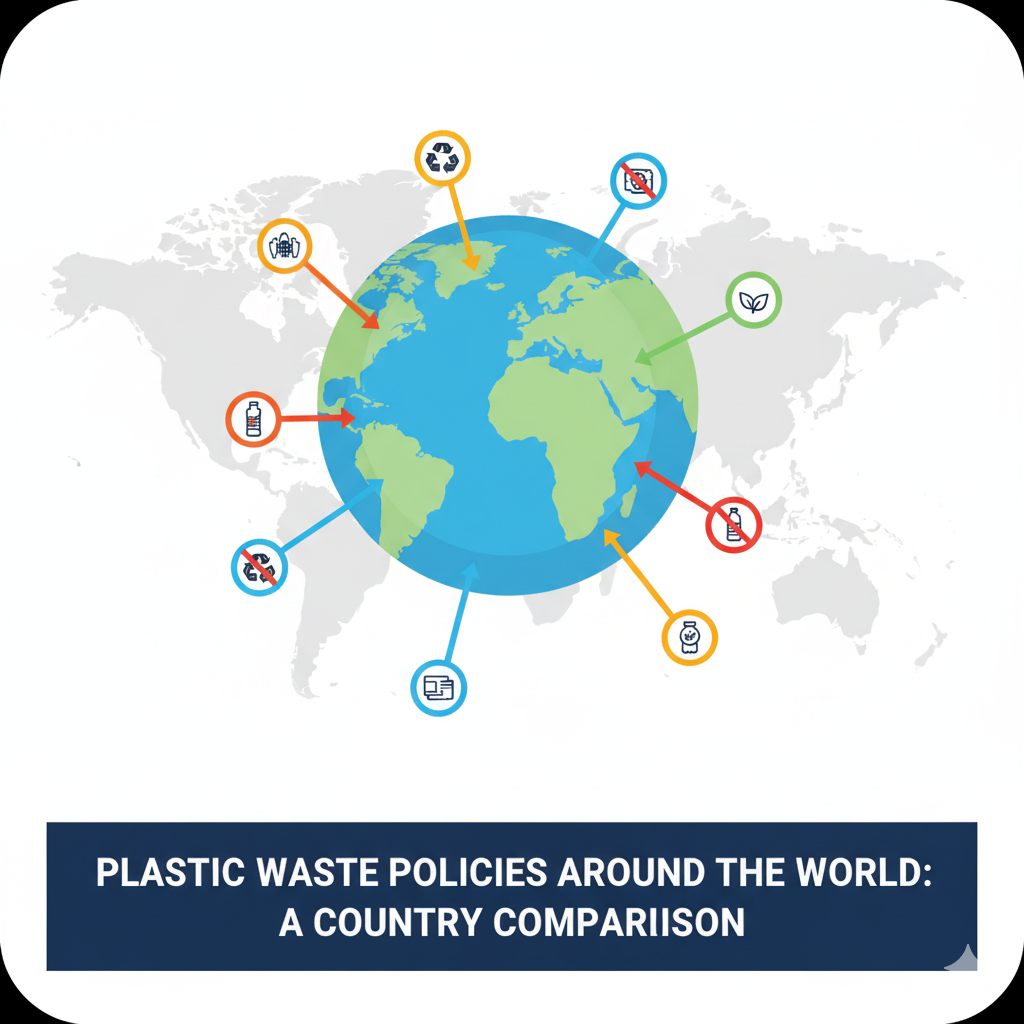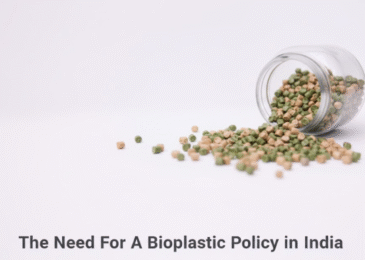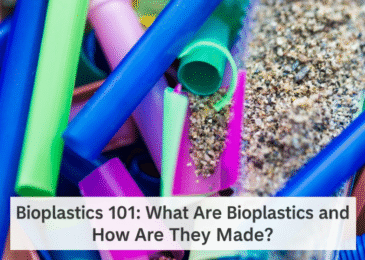Every year, the world produces more than 460 million tonnes of plastic.
Now pause on that number for a moment.
Can you dismiss it as just another statistic?
It’s more than that. This number represents a mountain of bottles, bags, wrappers, and packaging that we add to the planet each year. Out of this massive pile, only about 9% is recycled.
The rest?
- Some of it is burned, releasing toxic fumes.
- Some of it is dumped into landfills.
- And a shocking amount finds its way into our rivers, oceans, and even into our food chain.
The OECD reports that 82% of mismanaged plastic waste in 2019 leaked into the environment.
That means plastics are not only clogging landfills but also contaminating the ecosystems that sustain us.

The fish we eat, the water we drink, the soil where our crops grow—all of these are now carrying microplastics.
So when we talk about “plastic waste policies,” we are really talking about the future health of people, economies, and nature.
But countries are not tackling this challenge in the same way.
- Some nations with advanced waste-management systems focus on recycling and reuse.
- Others are investing upstream, trying to reduce plastic at the source.
- Many, however, still struggle with overflowing dumps, weak enforcement, and limited alternatives, even after banning single-use plastics.
And that raises the central question: why are some countries making progress while others are stuck?
To answer that, we first need to break down the types of global plastic waste policies in use today.
What are the main types of plastic waste policies?
Here are some of the main global plastic waste policies:
Single-Use Plastic (SUP) Bans
Outright bans on SUP items like plastic bags, straws, cutlery, and cups are one way to reduce waste before it even enters the stream.
Rwanda is perhaps the most striking example of this type of policy. The country was the first to ban non-biodegradable bags as early as 2008. In comparison, the European Union only banned single-use plastics in 2021.
Extended Producer Responsibility (EPR)
Another way to control plastic waste is to make manufacturers responsible for collecting and recycling the plastic packaging they sell.
Germany’s EPR system requires companies to pay recycling fees. India also made EPR mandatory for plastic packaging from 2022.
Recycling Targets
Some governments also set clear targets for how much plastic must be recycled each year.
For instance, the EU targets 90% collection of plastic bottles by 2029. Canada aims for 50% recycled content in some packaging by 2030.
Deposit-Return Schemes (DRS)
Under DRS schemes, consumers pay a deposit for bottles or cans and get it back when they return them.
Import/Export Bans
Restricting trade in plastic waste is another tactic. China’s 2018 import ban forced the world to rethink plastic waste exports. However, it ended up increasing exports to other Southeast Asian nations.
no single policy can solve the problem on its own.
Think of it this way—plastic leaks into our world at multiple points:
- when it is produced,
- when it is consumed,
- and when it is discarded.
If a government only addresses one of these stages, the pressure simply shifts to another. For example, banning straws might cut down consumption, but if packaging waste still flows unchecked, the bigger problem remains.
That’s why the strongest results come from combining policies. Countries that succeed usually build what I call a layered defense against plastic pollution.
Which countries have the strictest plastic waste laws?

Let’s look at the global plastic waste policies in countries, which have enacted recent or ambitious plastic waste legislation in the past two decades.
Rwanda
Many African countries have put in place outright bans on plastic bags (often 200–500 micron or less). 34 of 54 countries have some level of plastic bans.
Rwanda was the first to outlaw non-biodegradable plastic bags in 2008. Now, bans in the country cover other single-use plastic items as well. Border officials check baggage for banned items and violators face heavy fines. Monthly community clean-ups (Umuganda) are also a tradition for the last Saturday of each month in Rwanda.
Germany
The EU has one of the world’s tightest plastic regimes.
All Member States apply the Single-Use Plastics Directive, ban certain items, mandate EPR and set waste targets. But Germany has the highest municipal recycling rate in Europe (67%).
The German Packaging Act also makes manufacturers pay for recycling costs, which discourages excess packaging.
Taiwan
Taiwan’s long-standing “4-in-1” program integrates government, industry, recyclers and community. Residents buy official trash bags (pay-as-you-throw). Meanwhile, funds from industry (via EPR fees) subsidize collection. The country’s 55% household recycling is one of the highest in the world.
In 2020, Taiwan banned plastic disposable cups in cafes (except take-out). Also, this year, the country started to offer discounted EPR fees for plastic containers that use:
- at least 25% recycled materials, or
- meet green-design criteria (e.g. single material, minimal labels), with discounts up to 45%.
Japan
Japan is a leader with more than 85% plastic recycling (“Mottainai” conservation culture).
The country’s plastic bottle (PET bottles) recovery and recycling is among the world’s highest.
Under the 2022 Plastic Resource Circulation Act, Japan also pushed manufacturers to use:
- 60% recycled, or
- biodegradable content.
The country promotes easier-to-recycle design and charges for disposables.
China
China’s 2018 ban on plastic imports (National Sword policy) slashed global plastics imports by 99%. The country is now phasing out disposable plastics nationwide. The Hainan province has prohibited (production, sale, use) of non-degradable disposable products:
- bags,
- cups,
- straws,
- meal boxes, and
- other single-use plastic tableware.
The courier sector is also under regulation. The rules limit how much superfluous packaging can be used in the delivery of e-commerce parcels and parcel deliveries.
Canada
Canada also enacted one of the more comprehensive federal bans earlier this decade. The Single-Use Plastics Prohibition Regulations (SUPPR) banned the manufacture/import of six categories of single-use plastics.
The law also mandates that certain plastic packaging must include:
- at least 50% recycled content by 2030, and
- sets a 90% target for beverage bottle collection.
Plastic regulations are increasing around the world. But the exciting rules have brought real positive changes in only some countries. Let’s compare to see if or how countries with different plastic waste legislations have successfully managed pollution.
Plastic waste policies: Country comparison
Here is how global plastic waste policy differs in countries.
| Country / Region | Policy Features | Results / Data | Challenges |
| Rwanda | Ban on non‑biodegradable bags and many SUPs, community enforcement | Kigali is often cited as Africa’s cleanest city | Enforcement, smuggling of plastics and establishing alternatives |
| Germany | Packaging Act requiring producers to cover recycling; nationwide Pfand deposit system | 98% return rate on bottles/cans; very high recycling performance | Managing newer packaging forms (multi-layer, flexible plastics) |
| Taiwan | Advanced EPR, mandatory separation, bans on disposable items | 55% of total waste is recycled; 97% of plastic beverage containers captured | Scaling to other waste streams; pressure on incineration and landfill space |
| Japan | Strong waste separation culture and recent plastics law (2022) | Recycling rates above 85%; “Mottainai” ethos supports high citizen participation | Complexity of sorting rules; managing industrial & mixed plastics |
| Canada | Federal ban on six single-use plastics, EPR planning | No clear results | Coordinating federal and provincial laws; upgrading domestic recycling capacity |
| USA | State-level bans, bottle bills in select states, but no unified federal plastics policy | Low plastic recycling rates; plastic export leakage | Fragmented regulations |
| India | National ban on some identified single-use plastics (2022); mandatory EPR for plastic packaging | Low plastic recycling rate; EPR compliance just beginning | Enforcement gaps across states, weak waste-management infrastructure, heavy reliance on informal sector |
It’s true that policy can move both markets and human behavior. Taxes change what we buy. Bans change what producers make. Recycling targets change how cities collect waste.
But here’s the hard reality: even the best-designed policies face real-world hurdles.
Many countries pass laws with good intentions, yet the results on the ground remain limited.
That said, there are some encouraging signs.
- Between 2018 and 2022, global production of recycled plastics grew by 19%.
- In comparison, virgin plastics (the ones made fresh from fossil fuels) grew by just 8% in the same five-year window.
So while the momentum is positive, the road ahead is far from smooth. And this brings us to the crucial question: how do we learn from countries that are navigating these hurdles better than others?
Challenges in global plastic policy enforcement?
Policies meet friction on the ground, no matter how thoughtfully written. Here are the problems plastic regulation around the world needs to overcome:
Weak enforcement and governance gaps
Several laws are not enforced. In Kenya, smuggled plastic bags still circulate despite years of bans. And in India, enforcing EPR rules across all states is still highly uneven.
Informal sector integration
In many developing nations, informal waste collectors handle the lion’s share of plastic collection. Unless they are included in formal systems, part of the value chain is excluded.
A global framework recommends integrating waste pickers into EPR and DRS systems.

Trade and waste dumping pressure
Many developing countries are also swamped with contaminated imports they cannot process. A 2023 UN report underestimated an annual 1.8 million metric tons (Mt) of hidden plastics waste exports in contaminated loads.
China’s 2018 ban on plastic imports (National Sword policy) slashed global plastics imports by 99% but shifted waste flows to Southeast Asia and beyond.
Fragmentation and policy conflict
Different rules at the state and federal level can also confuse citizens and suppliers. For instance, in the USA, state-level bans often clash with national laws that forbid local bans.
Rising plastic consumption outpacing policy
Even as recycling and bans increase, plastic production is projected to nearly double by 2050. It is expected to go form 464 Mt to 884 Mt under business-as-usual trends. Without demand‑side limits or caps, policies constantly play catch-up.
Addressing these challenges head-on is important if policies are to realize their potential. Effective systems rarely rely on a single tool.
Perhaps the best approach is to build the strongest bundle of regulatory, economic, and social levers.
Meanwhile, innovation is also not optional.
Developing local alternatives to single-use plastic might be the key to reducing plastic pollution at scale. UKHI’s EcoGran converts agricultural waste into biopolymers to help countries meet policy goals. We use hemp, nettle and flax residues to:
- create locally sourced feedstocks as a sustainable alternative, and
- reduces the load on the plastic recycling system.
Our compostable biopolymer products have multiple applications in packaging, foodservice and healthcare industries.
FAQs
What country produces the most plastic waste?
China, the USA, and India lead in absolute plastic waste. China alone leaked 4.9 million tons in 2022.
Which country has the best plastic waste policy?
There is no single best global plastic waste policy. However, Germany’s recycling model is a strong contender for ideal waste management. Rwanda’s robust bans on SUP items are another way to manage waste.
How does EPR (Extended Producer Responsibility) actually work?
Producers pay for or manage the collection and recycling of packaging they put in the market. They may form Producer Responsibility Organizations (PROs) to run the logistics.
Is banning single-use plastics effective?
SUP bans are effective when they are backed by good enforcement and public awareness. Otherwise, bans may drive black markets or shift waste burdens.






